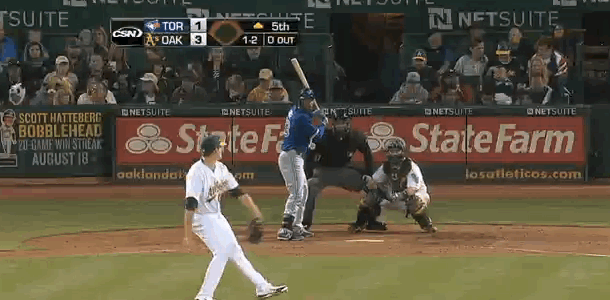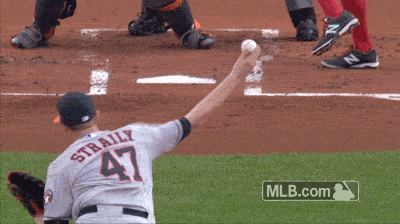Can Dan Straily Keep Beating BABIP?
As a former prospect struggling to find his footing in the majors, Dan Straily wasn’t given an extended look in a big-league rotation after 2013. He bounced around from the A’s to the Cubs to the Astros. Now he’s on the rebuilding Reds. With the Reds, he has finally gotten another shot. The Reds were looking for someone with any kind of upside to fill the hole in their rotation. Straily fit the bill. 154 innings later, Straily is running an insanely low .239 BABIP, the third-lowest among qualified starting pitchers. That has helped him to a solid 3.92 ERA, which was at 3.50 before a recent blowup against the Angels. Before then, however, he had managed 10 starts in a row without allowing more than three runs. Can Straily keep running a BABIP this low? Let’s find out.
The first thing that sticks out to me about Straily is that he’s an extreme fly-ball pitcher. He has the third-lowest groundball percentage and the eighth-highest fly-ball percentage among qualified starters. He also has allowed the 11th-highest average launch angle on batted balls out of the 92 pitchers who have thrown at least 2000 pitches this year. Ground balls go for hits far more often than do fly balls (although fly balls go for extra-base hits far more often), so that explains part of why Straily has such a low BABIP.
If you’re like me, you would have thought that since Straily gets a lot of fly balls, maybe he gets a lot of popups. That would certainly help him keep a low BABIP, as popups almost never go for hits. Although Straily’s fastball has good rise (he’s tied for 27th out of the 78 qualified starters who throw four-seamers), he doesn’t actually generate many popups. In fact, his IFFB% of 7.9% this year puts him firmly below the league average of 9.7%. While his career IFFB% is at 11.8%, that doesn’t help explain why he’s run such a low BABIP this year specifically. Let’s look elsewhere.
Does he do a good job of limiting quality contact? He has allowed the 39th-highest exit velocity out of the 92 pitchers who have thrown at least 2000 pitches this year. That’s below average. He’s also below average in terms of hard-hit rate: he has the 30th-highest out of the 81 qualified pitchers. Worse, he’s tied for the seventh-lowest soft-hit rate. His line-drive rate is worse than average, the 32nd-worst out of 81. These are some troubling signs.
On the other hand, there is some good news. Straily has a nasty changeup. Observe:

Of the 73 qualified pitchers who throw a changeup, Straily’s is tied for the sixth-most drop. That’s not surprising, especially when you consider this: there are 133 pitchers who have thrown at least 150 changeups this year, and Straily’s has the fifth-lowest average spin rate. A low spin rate allows gravity to do its job and make that sucker drop right off the table.
Straily has a nice slider, too. It’s a frisbee, with solid horizontal movement and decent drop, without sacrificing too much velocity. Observe:

I don’t think that Straily will maintain a .239 BABIP. Although his extreme fly-ball tendencies seemingly make it easier for him to maintain a lower BABIP, he doesn’t do enough things right otherwise. He allows too much quality contact. On the other hand, he has three solid pitches, which are also his three most-used pitches (his sinker and curve aren’t great, and he uses them accordingly). His four-seamer has good rise, and, despite mediocre velocity, that can work. Just look at what Marco Estrada is doing with a four-seamer that has good rise and averages a mere 88 MPH.
Straily’s change and slider have above-average swinging-strike rates, at 15.8% and 14.5%, respectively. The change and slider even have average groundball rates (44.9% and 46.7%). They both have lofty O-Swing percentages as well, which leads me to believe their swinging-strike rates are for real (45.5% and 38.8%). My advice for Straily would be to stop pitching to contact. He seems to be pitching to contact because his Zone% this year is at 46.9%, the highest of his career. That mark ties him for 20th-highest among the 81 qualified starters. It is far above the league average of 44.8%. So, he should stop pitching to contact because 1) he has strikeout potential and it would be worth trying to tap into it and 2) his luck with BABIP will probably run out soon.
Data from FanGraphs and Baseball Savant. Gifs courtesy of Bleacher Report and MLB.com.
Thanks for reading!
Alex is a FanGraphs contributor. His work has also appeared at Pinstripe Alley, Pitcher List, and Sports Info Solutions. He is especially interested in how and why players make decisions, something he struggles with in daily life. You can find him on Twitter @Mind_OverBatter.
